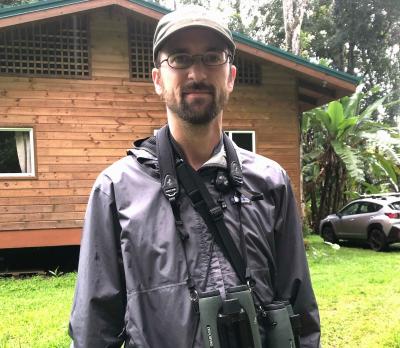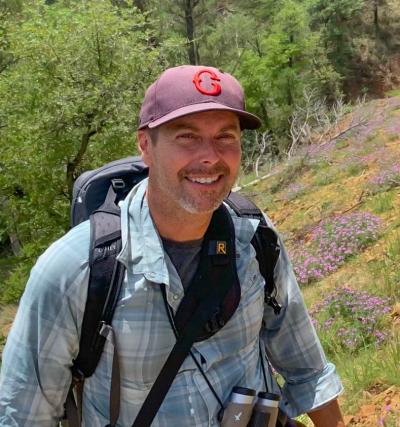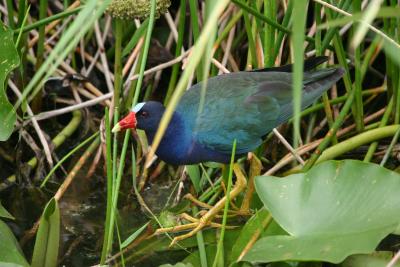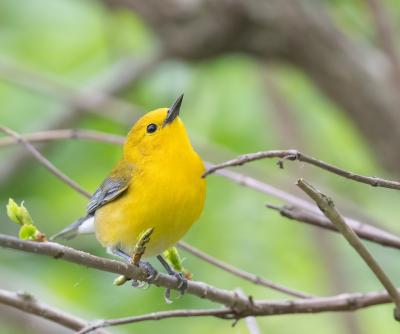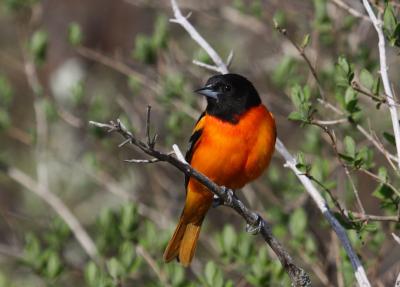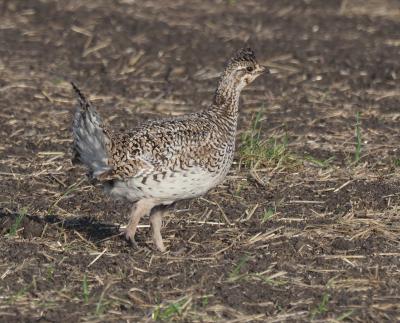Texas: The Rio Grande Valley in Spring
-
Apr 8-17, 2025
Ethan Kistler
-
Apr 2026
Ethan Kistler
2025
Single Room Supplement $650
2026
Tour Price to be Determined
2025
Single Room Supplement $650
2026
Tour Price to be Determined
South Texas has some of the most distinctive avifauna in the contiguous United States; no fewer than 30 species are restricted to the region. In addition, early April brings a wide array of northbound migrant passerines, raptors, and shorebirds resulting in a truly staggering bird diversity. The lower Rio Grande Valley is also well known for hosting the occasional vagrant bird and we’ll keep tabs on this during the tour so that we don’t miss anything exciting.
We’ll have a full week to explore a range of faunal regions, from the broad coastal plain with its shallow lagoons and grasslands to the scrubby mesquite/cactus forests of the drier uplands, and finally to the dense stands of sabal palm, huisache, Texas ebony, and Montezuma bald cypress that line the river itself.
Day 1: The tour begins at 6:00 pm in Corpus Christi. If weather conditions permit, we’ll visit a local park for an hour of birding before dinner. Night in Corpus Christi.
Day 2: We’ll spend most of the day at the iconic King Ranch, which is the largest ranch in the U.S. Covering 1,289 square miles; it is roughly the size of Rhode Island. Here our main target will be Ferruginous Pygmy-Owl but we’ll also have excellent chances for other difficult species including Tropical Parula and Northern Beardless-Tyrannulet. We’ll also get our first taste of South Texas birding with the likes of Great Kiskadees, Green Jays, Long-billed Thrashers, and perhaps Audubon’s Oriole. Raptors should be common with Crested Caracara, White-tailed Hawk, and Harris’s Hawk all likely to be seen. In the late afternoon, we’ll arrive in the Rio Grande Valley and, if time permits, we’ll bird one of the many local birding hotspots. At dusk, we’ll visit an Elf Owl stakeout. Night in McAllen.
Day 3: We’ll depart early for Bentsen-Rio Grande Valley State Park or Santa Ana National Wildlife Refuge, both of which hold the vast majority of the valley specialties. We’ll search for our first Plain Chachalaca, White-tipped Dove, Ringed and Green Kingfishers, Clay-colored Thrush, and Altamira Oriole. The hawk towers at both parks can be very productive for raptor migration, and we may spend some time observing large numbers of raptors passing overhead, most notably large kettles of Broad-winged Hawks. If we’re lucky, we may even see a Hook-billed Kite. After lunch, we’ll venture upstream to the desert chaparral of Falcon State Park. Here among the cactus and scrubby mesquite, we’ll look for a variety of desert birds not easily found in the lower valley, such as Pyrrhuloxia along with Lark, Clay-colored, and Black-throated Sparrows. Night in Zapata.
Day 4: Today we’ll enjoy dawn chorus along a quiet road just outside Zapata, where we have an excellent chance at finding Scaled Quail, Black-tailed Gnatcatcher, and Cactus Wren among the usual suspects. We’ll then head to San Ygnacio Bird Sanctuary where an observation tower allows a good vantage point looking across the Rio Grande River into Mexico. Morelet’s Seedeater is frequently present, and we should be able to pick up Red-billed Pigeon flying along the river or even perched in a nearby tree. This area is generally quite birdy, and we’ll accumulate a decent list by the time we head for lunch. The latter half of the day will be birding other local sites where we may see Vermilion Flycatcher, Audubon’s Oriole, and migrant warblers. If time permits, we’ll return to Falcon Dam to see what waterfowl and shorebirds we may find. Night in Zapata.
Day 5: We’ll devote the morning to searching for any species we may have missed before working our way back toward the east. The rest of the morning will be spent at Estero Llano Grande State Park where we may see close to a hundred species by the time we leave! The array of wetlands holds a good number of ducks, and we may be able to pick out a Fulvous Whistling-Duck among the masses of Black-bellied. Shorebirds and other waterbirds will be well represented, and we’ll also search for a resident Common Pauraque, which roosts around the same spot every day. We’ll then venture to the other half of the park, which consists of typical Rio Grande woodlands with orioles, migrant warblers, and valley specialties. Night in McAllen.
Day 6: Today we’ll head to the coast to explore the migration hot spot of South Padre Island. The southern part of the island is quite developed, but some small sanctuaries, several with permanent water, and several well-vegetated and little-traveled residential streets can attract literally thousands of brightly colored migrant warblers, tanagers, orioles, and grosbeaks. Such “fallouts” require the right weather conditions, but if we’re lucky enough to be there when one occurs, the spectacle is simply astonishing. We’ll also seek out shorebirds and terns, possibly including American Avocet, Marbled Godwit, Gull-billed, and Sandwich Terns, and will have plenty of time to sort through the pertinent field marks of each species present. After a seafood dinner on the island, we’ll venture out to a nearby marsh at sunset to watch for emerging rails and, with some luck, perhaps a Purple Gallinule or Least Bittern. Night in Harlingen.
Day 7: This morning we’ll visit the National Audubon Society’s Sabal Palm Sanctuary, the largest extant native palm forest in the lower Rio Grande Valley. In addition to the palms, the sanctuary’s numerous ponds, grasslands, and Rio Grande riparian forest support large numbers of area specialties including Green Jay, Great Kiskadee, and White-tipped Dove, and one never knows what rarities might occur. If Tamaulipas Crows are present this year, we’ll visit another of the valley’s famous birding locations, the scenic, if fragrant, Brownsville dump. Several rare gulls have also been found here, but even if there are none, we should get fine views of migrant Franklin’s Gulls, at this season especially lovely with their rosy breasts. In the afternoon we’ll venture out to the long sand beaches of Boca Chica, where the Rio Grande empties into the Gulf of Mexico. On the way, we’ll pass through the Texas coastal plain where we hope to encounter White-tailed Hawk, Aplomado Falcon, and a host of gulls, shorebirds, and wading birds. Night in Harlingen.
Day 8: Today we’ll return to South Padre or, if migration is light, we’ll visit Laguna Atascosa National Wildlife Refuge where bays, beaches, mudflats, and grasslands host flocks of Roseate Spoonbills and White-faced while the grassy scrub holds White-tailed Kite, Botteri’s Sparrow, and some of the largest Western Diamondback Rattlesnakes in Texas. Night in Harlingen.
Day 9: We’ll depart the valley early on our final morning and return north to Corpus Christi. Our first stop will be at Pollywog Ponds where we should be able to find some new migrants. We’ll then hop over to Mustang Island where we will bird a couple of migrant traps before arriving at the Port Aransas area. Here there are a couple of excellent birding stops including Joan and Scott Holt Paradise Pond, which is a short boardwalk through a marsh where we may see bitterns up close and spot migrants in the trees surrounding it. Just down the road is the Leonabelle Turnbull Birding Center, which has a small section of trees that act as a migrant trap along with a nice boardwalk and observation tower overlooking a wetland chockablock full of shorebirds, ducks, rails, and more. We’ll return to Corpus Christi and any remaining time will be spent at a couple of migrant traps in the city center. Night in Corpus Christi.
Day 10: The tour concludes this morning in Corpus Christi.
Note: The information presented here is an abbreviated version of our formal General Information for Tours to Texas: The Rio Grande Valley in Spring. Its purpose is solely to give readers a sense of what might be involved if they take this tour. Although we do our best to make sure that what follows here is completely accurate, it should not be used as a replacement for the formal document which will be sent to all tour registrants, and whose contents supersedes any information contained here.
ENTERING THE UNITED STATES: Non-U.S. citizens will need a valid passport and may need a tourist visa or visa waiver. Consult your nearest U.S. Embassy or consulate for details. Canadian citizens should carry proof of citizenship in the form of a passport or birth certificate.
COUNTRY INFORMATION: There is no U.S. Department of State Country-Specific Travel Information for the USA. You can review foreign travel advice from the UK government here: https://www.gov.uk/foreign-travel-advice and travel advice and advisories from the Government of Canada here: https://travel.gc.ca/travelling/advisories. You can access the CIA World Factbook background notes on the United States here: https://www.cia.gov/the-world-factbook/countries/united-states/
PACE OF THE TOUR: This is a relatively relaxed tour although days will be full, with departures usually around 7:30AM and return to the hotel usually by 5 PM. On a few days we will schedule a one to two hour siesta during the heat of the day. Although we spend much time on foot, our walks are at a leisurely pace and on flat terrain and we will have plenty of time to study the birds we see. There will likely be at least one (optional) night birding expedition and at least two dusk outings to look at parrot roosts and rails. Note that the published WINGS itinerary should be viewed as a general guide. The actual daily itinerary (locations and order) can change due to local birding conditions and the discovery of any special rarities.
HEALTH: South Texas presents no real hazards to the visiting birdwatcher.
Sun: In summer, which extends from April to October, the sun can be intense. A broad-brimmed hat, proper clothing and strong sunscreen lotion are important.
Insects and Arachnids: Texas has mosquitoes, ticks and chiggers. We recommend using insect repellents with a high concentration of DEET. However, care must be taken to avoid getting the DEET repellent on optical equipment as DEET dissolves rubber and plastic and can damage coated lenses. Camping supply stores and outfitters carry some reasonably effective alternatives that contain natural products and aren’t corrosive.
Smoking: Smoking is prohibited in the vehicles or when the group is gathered for meals, checklists, etc. If you are sharing a room with a nonsmoker, please do not smoke in the room. If you smoke in the field, do so well away and downwind from the group. If any location where the group is gathered has a stricter policy than the WINGS policy, that stricter policy will prevail.
CLIMATE: April temperatures can vary from the 50s F (occasionally even the upper 40s) to the upper 80s or even 90s during the day. Temperatures will be a bit lower near the coast. Wind and rain are possible anywhere.
ACCOMMODATIONS: We stay at standard motels throughout. All of our hotels offer free WIFI.
FOOD: We’ll eat in a variety of local restaurants where the food will in most cases be American standard. We will however make sure to include good selections of Tex-Mex, BBQ and seafood, all of which are excellent in the valley. Breakfasts are generally taken in our hotels (continental plus), and lunches will be in local or chain sandwich stores or cafes.
WINGS tours are all-inclusive; no refunds can be issued for any missed tour meals. While our restaurants and ground agents make every effort to insure the comfort of all participants, we cannot guarantee that all food allergies can be accommodated at every destination. Many restaurants offer set menus and are unable to accommodate all special requests within a group. Thus, participants with significant food allergies or special dietary needs should bring appropriate foods with them for those times when their needs cannot be accommodated. Our tours are carefully scheduled to insure the best possible birding experience. Meal times can generally not be adjusted; any participant who needs to eat earlier or later than the times scheduled for the group should bring supplemental food. Please contact the WINGS office if you have any questions.
Food Allergies / Requirements: We cannot guarantee that all food allergies can be accommodated at every destination. Participants with significant food allergies or special dietary requirements should bring appropriate foods with them for those times when their needs cannot be met. Announced meal times are always approximate depending on how the day unfolds. Participants who need to eat according to a fixed schedule should bring supplemental food. Please contact the WINGS office if you have any questions.
TRANSPORTATION: We will be traveling by 12 or 15 passenger window van or minivan, depending on the group size. Participants should be able to ride in any seat in tour vehicles.
2024 Narrative
This year’s Rio Grande Valley Spring Tour coincided with the total solar eclipse, so we added a pre-tour extension to Kerrville in the Texas hill country to witness this spectacle. We had the opportunity to revel in the incredible experience all the while being serenaded by Black-capped Vireos and Golden-cheeked Warblers.
Afterward, we continued with the regular tour itinerary starting in Corpus Christi where we quickly picked up the long-staying vagrant Cattle Tyrant, which has been hanging out in the downtown area for several months now. The next morning enjoyed a tour of King Ranch and, with that, great views of several key targets there: Ferruginous Pygmy-Owl, Tropical Parula, and Northern Beardless-Tyrannulet.
Further south, we spent several days birding along the Rio Grande where we had an excellent selection of South Texas specialties such as Green and Brown Jays, Plain Chachalacas, Olive Sparrows, Ringed and Green Kingfishers, Red-billed Pigeon, Morelet’s Seedeater, and Muscovy Duck. Luck was on our side as two vagrants appeared during our stay, a Southern Lapwing and Mexican Violetear. Both cooperated for the group.
Migration was below average this year, but between several visits to South Padre Island and the migrant traps around Port Aransas, we still accumulated a great list of migrant warblers, vireos, thrushes, sparrows, and more.
SOLAR ECLIPSE EXTENSION
We began the pre-tour extension with a visit to Warbler Woods Bird Sanctuary, a private sanctuary east of San Antonio. Here we had our first taste of Texas birding with the likes of Golden-fronted Woodpecker, Black-chinned Hummingbird, Crested Caracara, Scissor-tailed Flycatcher, Long-billed Thrasher, and two migrant warblers: Orange-crowned and Nashville. This property was excellent for sparrows and provided no fewer than nine species including Grasshopper and a Green-tailed Towhee among the plentiful Spotted Towhees. From here, we headed to a nearby park, stopping along the way at a productive field that had flocks of sparrows feeding including Lark, Vesper and Savannahs, while the park itself provided over a dozen lingering American Pipits.
The latter half of the day was spent at Lake Mitchell Audubon Center where we had a large picnic lunch followed by very productive birding around the various units of water. Ten species of ducks were had including Cinnamon Teal, American Wigeon, Northern Pintail, and a single Canvasback. Other birds included Least and Eared Grebes, White-faced Ibis, Bell’s Vireo, Black-crested Titmouse, and Cassin’s Sparrow. However, the real highlight was the impressive diversity of shorebirds… sixteen species to be exact! Long-billed Dowitchers were common while smaller numbers of Wilson’s Phalarope, Stilt, Baird’s and Western Sandpipers, and a couple of American Golden-Plovers were also had.
We departed San Antonio towards Kerrville the following morning to stake out our eclipse viewing spot. We made a brief visit to Flat Rock Lake for a reported Brown Booby, which did not show, but a flock of Cedar Waxwings and a couple of Yellow-throated Warblers were nice additions.
The rest of the morning and afternoon was spent relaxing at Kerrville Wildlife Management Area, which was far from the eclipse crowds. Only a few other, mainly birders, around! The two specialties to the Texas Hill Country, Black-capped Vireo and Golden-cheeked Warbler were both seen very well right along with Ladder-backked Woodpecker, Black-throated and Rufous-crowned Sparrows, Yellow-throated Vireo, and Black-and-white Warbler. Just after 2 pm, the eclipse began and, despite the clouds, we were able to get excellent views of the partial and eventually total eclipse. Totality occurred, most birds went very quiet, and once totality ended, we experienced a second dawn chorus including a Northern Bobwhite singing away. With the darkness, migrant raptors were forced down and we had Sharp-shinned and Cooper’s Hawks, Crested Caracara, and plenty of Turkey Vultures all flying very low. A trio of Pine Siskins was a nice addition.
MAIN TOUR
The group met in our hotel lobby at 6pm and we set off for dinner. Along the way, we made an obligatory stop at a particular dumpster in the heart of Corpus Christi, where a vagrant Cattle Tyrant had been hanging around for a couple of months. An excellent first bird of the trip before retiring to our delicious dinner at a seaside seafood restaurant.
An early departure the next morning found us at the gate of King Ranch just after dawn. Along with a ranch guide, we spent the morning traversing this vast property, which is about the size of Rhode Island. Our main focus this morning was tracking down Ferruginous Pygmy-Owl and Tropical Parula; we were very successful on both fronts! Other highlights around the ranch included Harris’s Hawk, White-tailed Hawk, Northern Beardless-Tyrannulet, Vermilion Flycatcher, a flyover Upland Sandpiper, and a pair of Wood Ducks, which are quite rare for here.
We then continued south into the Rio Grande Valley but detoured onto South Padre Island for a reported Mexican Violetear. This proved to be a good idea as we were able to get great views of this vagrant hummingbird. There were also a few migrants around such as Tennessee and Black-throated Green Warblers, Indigo Buntings, and Western Kingbirds.
As if the day was not jam-packed enough already, we ventured out after dinner to Bentsen-Rio Grande Valley State Park to watch the resident Elf Owl depart its nesting site after dusk. While waiting we had Couch’s Kingbird, a flyover Cave Swallow, and multiple Common Pauraque calling. Eventually, the Elf Owl poked its head out for a bit and then flew off. We lingered around a little longer and had a second individual calling in the tree right beside us and eventually flying into the hole.
The next morning, we went to my favorite park in the valley, Santa Ana National Wildlife Refuge. Here most of the valley species can be found, very few people around, and also plenty of water and mudflats to provide an excellent diversity of species. We had already tallied 90 species by 11am! On our walk in we had great views of raucous Plain Chachalacas, some White-tipped Doves on the trails, and Brown-crested Flycatchers welcoming us. We spent some time on the observation tower where we scanned for raptors finding both vultures, Osprey, Northern Harrier, Sharp-shinned, Gray, a Swainson’s Hawks, and a couple dozen migrating Broad-winged. Other birds included Hooded and Altamira Orioles, Ringed Kingfisher, Clay-colored Thrush, Great Kiskadee, Loggerhead Shrike, and a cryptic Great Horned Owl roosting in a large distant tree. We then walked around the various lakes and mudflats tallying ten species of waterfowl, a dozen species of shorebirds, and various waterfowl including Black-bellied and Fulvous Whistling-Ducks, Sora, Stilt Sandpiper, Caspian Tern, Neotropic Cormorant, Little Blue and Tricolored Herons, and four Roseate Spoonbills.
After lunch, we began working our way upriver towards Zapata stopping at Falcon State Park. Here we had the usual more arid species such as Greater Roadrunner, Ash-throated Flycatcher, Bewick’s Wren, Bullock’s Oriole, and Pyrrhuloxia. Our first attempt at Morelet’s Seedeater in Zapata left us empty-handed, but we still had a couple more days to try for this localized species within the U.S.
The next morning was spent in the infamous Santa Margarita Ranch, which has been hosting a lot of vagrants in the last few months. While most of these had moved on, we still had a productive morning birding this vast property on our own. It should be mentioned that this ranch is closed to the public and can be only visited with a few guides who have access, which I do. Starting from the bluffs overlooking the Rio Grande, we enjoyed the early morning seeing what birds utilized the important riparian zone. One highlight was a pair of wild Muscovy Ducks, which showed no signs of having a domestic parent. Mexican Duck, Red-billed Pigeon, Green Kingfisher, Chihuahuan Raven, and Clay-colored Thrush were some of the other highlights. Elsewhere around the ranch we added Black Phoebe, migrant Blue-headed Vireos, and two of the long-staying Brown Jays. These jays are the only known Brown Jays in the entire U.S. as the rest of their population occurs further south in Mexico and Central America.
We tried our second attempt at Morelet’s Seedeater turning up empty-handed yet again, so we moved on to a road outside of Zapata where we added Scaled Quail, Black-tailed Gnatcatcher, Cactus Wren, and a Texas Horned Lizard.
Before heading back east along the river the following morning, we made our last attempt at Morelet’s Seedeater and heard one singing right off the bat. After some searching, we had excellent views of this valley specialty. Also present was a late female Ring-necked Duck in one of the ponds.
Salineño Wildlife Preserve was productive where we had both Mottled and Mexican Ducks for comparison, a couple of Groove-billed Anis, good views of a Marsh Wren, Yellow-breasted Chat, and Rio Grande Cooter. We eventually made it back to the lower valley where our final stop of the day was the National Butterfly Center where an Audubon’s Oriole visited the feeder. It didn’t show this time around, but we did enjoy close views of a lot of the Valley specialties including Buff-bellied Hummingbird along with our first Eastern Kingbird and a locally rare Bell’s Vireo.
That evening we had an earlier dinner so that we could hit a couple of spots around McAllen at dusk for parrots. We easily found nearly 30 Green Parakeets and about 10 Red-crowned Parrots along with a bonus Peregrine Falcon.
News came in the previous night about a Southern Lapwing, a very rare vagrant to the U.S., that had appeared at a local golf course. Of course, this was our first stop the next morning where we were successful seeing this Central and South American shorebird. We then popped over to the nearby Estero Llano Grande State Park. Although most of the ponds were dried up thanks to drought and a broken water pump, we still had an enjoyable walk adding Yellow-billed Cuckoo, a roosting Common Pauraque, and Yellow-crowned Night-Heron, while the feeders hosted Ruby-throated, Black-chinned, and Buff-bellied Hummingbirds for close comparison views.
Lunch was enjoyed at a local taqueria where a nesting pair of Curve-billed Thrashers kept us entertained. Nearby Frontera Audubon Center had a Crimson-collared Grosbeak hanging out that was unreliable and notoriously difficult to see, often taking people multiple trips just to even hear it. After a dedicated search, we only came up with a single call, but did see a couple of Javelinas.
By now the winds had increased so we pointed our focus towards driving around agricultural fields for shorebirds. The first couple of fields provided twenty or so Buff-breasted and Upland Sandpipers, Horned Lark, and 25 Hudsonian Godwits on a reservoir. Eventually, we stuck gold with a very productive field that hosted no fewer than 105 Buff-breasted Sandpipers! What an incredible sight. We also had 8 Long-billed Curlews and a very lost Wilson’s Plover, which is normally restricted to coastal beaches, not a sod farm.
The following morning, we ventured down to Brownsville, the southernmost point in Texas, and birded around the University of the Rio Grande Valley Brownsville campus. A large natural area encircles a resaca is found right in the middle of campus and hosts the occasional rarity. Despite turning nothing rare up today, we did pick up our first Painted Bunting among the usual suspects. Next, we visited Palo Alto Battlefield National Historical Park where we quickly found the recently arrived Botteri’s Sparrow, before heading towards the coast via picking up an Aplomado Falcon en route.
On South Padre Island, or SPI, we found some lingering Redheads in a resort pond before heading to the Valley Land Fun Lot. This partial of land among houses was not developed and is now one of the key migrant stopover sites. Migration was light but we did have a Magnolia Warbler, which is uncommon in this part of the U.S. Further up the road we spent some time sifting through large flocks of roosting shorebirds, gulls, and terns around a large expansive mudflat. Highlights include Piping Plovers, Marbled Godwits, Willets, Ruddy Turnstones, Sanderling, Least Terns, and over 260 Black Skimmers.
We found ourselves returning to SPI the next morning stopping again for more views of the Aplomado Falcon, which we did, along with our first Whimbrel and White-tailed Kite. The SPI Birding and Nature Center was quite productive with American Oystercatcher, Reddish Egret, superb views of a Clapper Rail, and several warblers namely Wilson’s, Blackpoll, and Northern Waterthrush. After a tasty lunch, we headed back to the Valley Land Fun Lot where we added Lesser Nighthawk, Warbling Vireo, Swainson’s Thrush, and Baltimore Oriole along with a couple of excellent looks of male Painted Buntings.
Heading back inland, we went to a retention pond next to a sugar cane factory which was hosting no fewer than 1,000 ducks and 2,500 shorebirds. Hudsonian Godwit, Wilson’s Phalarope, Franklin’s Gull, and Gull-billed Tern were some of the new additions along with the usual suspects. After dinner, we popped into Hugh Ramsey Park in Harlingen to try our luck at some night birds. Owls were quiet but we did have several Lesser Nighthawks and at least a dozen Common Pauraques seen and heard…not to mention an Armadillo.
On our final day of birding, we left the Rio Grande Valley behind and headed back north to Corpus Christi. Upon arrival, we made a quick stop at Blucher Park to see if any migrants came in with the previous night’s favorable winds. A short walk yielded seven Chuck-will’s-widows, an Acadian Flycatcher, several warblers including our first Hooded and Northern Parula, and a Rose-breasted Grosbeak.
Port Aransas offered far more migrants and we spent a great deal of time sitting on the lawn at Leonabelle Turnbull Birding Center enjoying a constant stream of warblers and other migrants coming into the water drips under the line of small trees. Highlights include Orchard Oriole, seven species of warblers, several stunning male Painted Buntings up close, and a female Black-capped Vireo quite far from its usual range of the Texas Hill Country. We then walked the boardwalk into the marshes where we had a nice selection of the usual shorebirds, ducks, and waterfowl including both Marbled and Hudsonian Godwits, a cooperative Least Bittern, Yellow-headed Blackbird, and a singing Sedge Wren.
Nearby Holt Paradise was slow but did give us our only Worm-eating Warbler of the trip. A small migrant trap called “The Willows” had a reported Black-whiskered Vireo, which didn’t make an appearance despite a thorough search. We did have a small selection of migrants and a flyover Magnificent Frigatebird. Just before leaving the barrier islands to head back inland, we made one last stop adding Bufflehead and a single Horned Grebe mixed in a group of Eared Grebes as our final new bird of the tour. It was a great trip!
The tour itinerary, above, should be viewed as a general guide. The actual daily itinerary (locations and order) can change due to local birding conditions and the recent existence of any special rarities.
Maximum group size seven with one leader.













